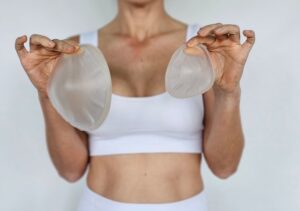How Long Do Breast Implants Last Before Needing Revision?
 For many years, it was customary to believe that breast implants had a shelf life of about 10 years. However, updated research and continued implant innovations have taught us that breast implants can often be fine for 20 to 30 years or longer, depending on the patient. While there may not be a magic number for when it is time to change breast implants, there are particular signs that can indicate when that time has come. Below, our board-certified plastic surgeon in Houston and specialist in revision breast augmentation surgery, James F. Boynton, MD, FACS, highlights some of the most common reasons why implants should be replaced.
For many years, it was customary to believe that breast implants had a shelf life of about 10 years. However, updated research and continued implant innovations have taught us that breast implants can often be fine for 20 to 30 years or longer, depending on the patient. While there may not be a magic number for when it is time to change breast implants, there are particular signs that can indicate when that time has come. Below, our board-certified plastic surgeon in Houston and specialist in revision breast augmentation surgery, James F. Boynton, MD, FACS, highlights some of the most common reasons why implants should be replaced.
First and foremost, there are several physical signs to be aware of that can mean a breast augmentation revision (or implant removal without replacement) is advised for medical reasons, including:
- Pain, tenderness, or hardening around the implant
- One breast hanging lower than the other
- Deflated breast appearance
- Visible implant edges beneath the skin
- Change in nipple direction
- Newly misshapen breast appearance
If you are experiencing any of the symptoms listed above, it is important to address them as soon as possible as there may be a complication with the breast implant, such as:
Capsular Contracture
This occurs when the scar tissue that naturally forms around the breast implant becomes hard and contracts around the implant, causing an abnormal appearance and/or a painful reaction.
Rupture
Saline implant ruptures are usually noticeable right away because once the saline solution starts to leak, the affected breast can become visibly smaller than the other breast. However, a rupture in a silicone breast implant may go unnoticed because the thicker gel may not leak right away. Therefore, it is highly recommended to screen silicone breast implants at approximately five to six years post-surgery and then every two to three years thereafter using either an ultrasound or MRI.1 More screenings may be recommended in certain cases, so it is important to follow your physician’s instructions.
Rippling
A wrinkled or rippled breast appearance can occur for a number of reasons. These may include a lack of breast tissue, an implant pocket that is too small, an implant size that is too big or too small for the individual, weight fluctuations, and other factors.
Bottoming Out
If skin and tissue cannot adequately support the breast implant, it will eventually cause the implant to fall below the natural crease of the breast. While some sagging is natural over time, a bottomed out implant will likely be apparent because the nipples will move upward, and the implants will fall lower. For many patients, Dr. Boynton can add a GalaFLEX® Scaffold to a revision breast surgery procedure or an initial breast enhancement procedure. This advanced, dissolvable internal bra mesh is designed to help reinforce breast tissues to slow the visible progression of ptosis (sagginess) and help the breasts maintain the desired projection for longer periods.
Alternatively, the time for breast implant revision may arise from a desire to exchange the implants for a smaller or larger size, an alternative shape, or a switch to a different material. Breast revision surgery can also move the placement of the implant, such as below the muscle from over the muscle, or adjust the positioning on the chest wall for a more natural look. Or, women may decide to remove their implants altogether and return to their natural breast state. Regardless of the reason, women should always feel comfortable discussing their needs and concerns, and a qualified, attentive plastic surgeon should welcome any questions they may have.
To learn more about revision breast augmentation surgery, or to schedule a consultation with Dr. Boynton, please contact us today.
1ASPS®: Breast Augmentation Safety